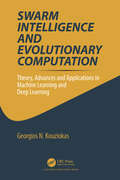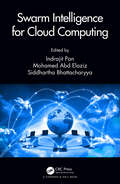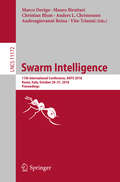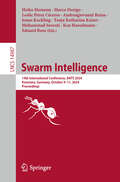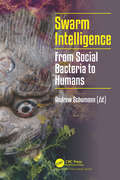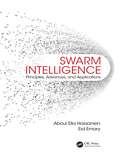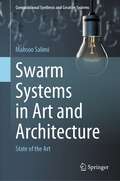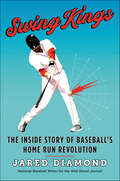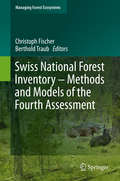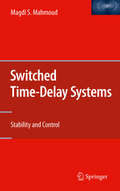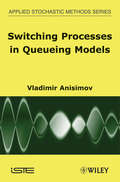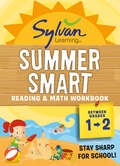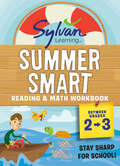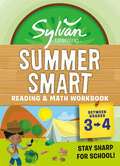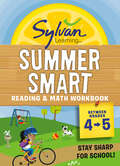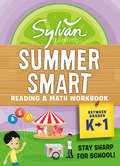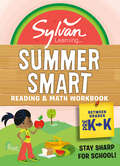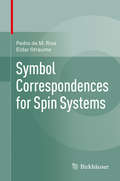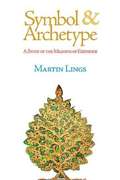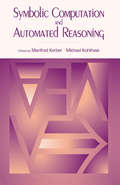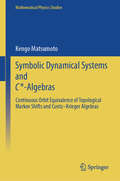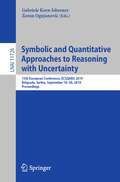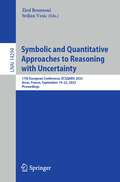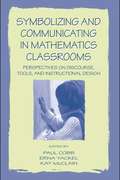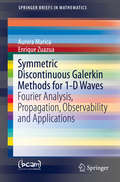- Table View
- List View
Swarm Intelligence and Evolutionary Computation: Theory, Advances and Applications in Machine Learning and Deep Learning
by Georgios N. KouziokasThe aim of this book is to present and analyse theoretical advances and also emerging practical applications of swarm and evolutionary intelligence. It comprises nine chapters. Chapter 1 provides a theoretical introduction of the computational optimization techniques regarding the gradient-based methods such as steepest descent, conjugate gradient, newton and quasi-Newton methods and also the non-gradient methods such as genetic algorithm and swarm intelligence algorithms. Chapter 2, discusses evolutionary computation techniques and genetic algorithm. Swarm intelligence theory and particle swarm optimization algorithm are reviewed in Chapter 3. Also, several variations of particle swarm optimization algorithm are analysed and explained such as Geometric PSO, PSO with mutation, Chaotic PSO with mutation, multi-objective PSO and Quantum mechanics – based PSO algorithm. Chapter 4 deals with two essential colony bio-inspired algorithms: Ant colony optimization (ACO) and Artificial bee colony (ABC). Chapter 5, presents and analyses Cuckoo search and Bat swarm algorithms and their latest variations. In chapter 6, several other metaheuristic algorithms are discussed such as: Firefly algorithm (FA), Harmony search (HS), Cat swarm optimization (CSO) and their improved algorithm modifications. The latest Bio-Inspired Swarm Algorithms are discussed in chapter 7, such as: Grey Wolf Optimization (GWO) Algorithm, Whale Optimization Algorithm (WOA), Grasshopper Optimization Algorithm (GOA) and other algorithm variations such as binary and chaotic versions. Chapter 8 presents machine learning applications of swarm and evolutionary algorithms. Illustrative real-world examples are presented with real datasets regarding neural network optimization and feature selection, using: genetic algorithm, Geometric PSO, Chaotic Harmony Search, Chaotic Cuckoo Search, and Evolutionary Algorithm and also crime forecasting using swarm optimized SVM. In chapter 9, applications of swarm intelligence on deep long short-term memory (LSTM) networks and Deep Convolutional Neural Networks (CNNs) are discussed, including LSTM hyperparameter tuning and Covid19 diagnosis from chest X-Ray images. The aim of the book is to present and discuss several state-of-theart swarm intelligence and evolutionary algorithms together with their variances and also several illustrative applications on machine learning and deep learning.
Swarm Intelligence for Cloud Computing
by Indrajit PanSwarm Intelligence in Cloud Computing is an invaluable treatise for researchers involved in delivering intelligent optimized solutions for reliable deployment, infrastructural stability, and security issues of cloud-based resources. Starting with a bird’s eye view on the prevalent state-of-the-art techniques, this book enriches the readers with the knowledge of evolving swarm intelligent optimized techniques for addressing different cloud computing issues including task scheduling, virtual machine allocation, load balancing and optimization, deadline handling, power-aware profiling, fault resilience, cost-effective design, and energy efficiency. The book offers comprehensive coverage of the most essential topics, including: Role of swarm intelligence on cloud computing services Cloud resource sharing strategies Cloud service provider selection Dynamic task and resource scheduling Data center resource management. Indrajit Pan is an Associate Professor in Information Technology of RCC Institute of Information Technology, India. He received his PhD from Indian Institute of Engineering Science and Technology, Shibpur, India. With an academic experience of 14 years, he has published around 40 research publications in different international journals, edited books, and conference proceedings. Mohamed Abd Elaziz is a Lecturer in the Mathematical Department of Zagazig University, Egypt. He received his PhD from the same university. He is the author of more than 100 articles. His research interests include machine learning, signal processing, image processing, cloud computing, and evolutionary algorithms. Siddhartha Bhattacharyya is a Professor in Computer Science and Engineering of Christ University, Bangalore. He received his PhD from Jadavpur University, India. He has published more than 230 research publications in international journals and conference proceedings in his 20 years of academic experience.
Swarm Intelligence: 11th International Conference, ANTS 2018, Rome, Italy, October 29–31, 2018, Proceedings (Lecture Notes in Computer Science #11172)
by Christian Blum Marco Dorigo Mauro Birattari Anders L. Christensen Andreagiovanni Reina Vito TrianniThis book constitutes the proceedings of the 11th International Conference on Swarm Intelligence, ANTS 2018, held in Rome, Italy, in October 2018. The 24 full papers and 12 short papers presented in this volume were carefully reviewed and selected from 69 submissions. They are devoted to the field of swarm intelligence as a whole, without any bias towards specific research directions.
Swarm Intelligence: 14th International Conference, ANTS 2024, Konstanz, Germany, October 9–11, 2024, Proceedings (Lecture Notes in Computer Science #14987)
by Marco Dorigo Heiko Hamann Andreagiovanni Reina Leslie Pérez Cáceres Jonas Kuckling Tanja Katharina Kaiser Mohammad Soorati Ken Hasselmann Eduard BussThis book constitutes the proceedings of the 14th International Conference on Swarm Intelligence, ANTS 2024, which took place in Konstanz, Germany, during October 9-11, 2024. The 14 ull papers and 5 short papers included in this book were carefully reviewed and selected from 33 submissions. They deal with self-organizing processes both in nature and in artificial systems.
Swarm Intelligence: From Social Bacteria to Humans
by Andrew SchumannThe notion of swarm intelligence was introduced for describing decentralized and self-organized behaviors of groups of animals. Then this idea was extrapolated to design groups of robots which interact locally to cumulate a collective reaction. Some natural examples of swarms are as follows: ant colonies, bee colonies, fish schooling, bird flocking, horse herding, bacterial colonies, multinucleated giant amoebae Physarum polycephalum, etc. In all these examples, individual agents behave locally with an emergence of their common effect. An intelligent behavior of swarm individuals is explained by the following biological reactions to attractants and repellents. Attractants are biologically active things, such as food pieces or sex pheromones, which attract individuals of swarm. Repellents are biologically active things, such as predators, which repel individuals of swarm. As a consequence, attractants and repellents stimulate the directed movement of swarms towards and away from the stimulus, respectively. It is worth noting that a group of people, such as pedestrians, follow some swarm patterns of flocking or schooling. For instance, humans prefer to avoid a person considered by them as a possible predator and if a substantial part of the group in the situation of escape panic (not less than 5%) changes the direction, then the rest follows the new direction, too. Some swarm patterns are observed among human beings under the conditions of their addictive behavior such as the behavior of alcoholics or gamers. The methodological framework of studying swarm intelligence is represented by unconventional computing, robotics, and cognitive science. In this book we aim to analyze new methodologies involved in studying swarm intelligence. We are going to bring together computer scientists and cognitive scientists dealing with swarm patterns from social bacteria to human beings. This book considers different models of simulating, controlling, and predicting the swarm behavior of different species from social bacteria to humans.
Swarm Intelligence: Principles, Advances, and Applications
by Aboul Ella Hassanien Eid EmarySwarm Intelligence: Principles, Advances, and Applications delivers in-depth coverage of bat, artificial fish swarm, firefly, cuckoo search, flower pollination, artificial bee colony, wolf search, and gray wolf optimization algorithms. The book begins with a brief introduction to mathematical optimization, addressing basic concepts related to swarm intelligence, such as randomness, random walks, and chaos theory. The text then: Describes the various swarm intelligence optimization methods, standardizing the variants, hybridizations, and algorithms whenever possible Discusses variants that focus more on binary, discrete, constrained, adaptive, and chaotic versions of the swarm optimizers Depicts real-world applications of the individual optimizers, emphasizing variable selection and fitness function design Details the similarities, differences, weaknesses, and strengths of each swarm optimization method Draws parallels between the operators and searching manners of the different algorithms Swarm Intelligence: Principles, Advances, and Applications presents a comprehensive treatment of modern swarm intelligence optimization methods, complete with illustrative examples and an extendable MATLAB® package for feature selection in wrapper mode applied on different data sets with benchmarking using different evaluation criteria. The book provides beginners with a solid foundation of swarm intelligence fundamentals, and offers experts valuable insight into new directions and hybridizations.
Swarm Systems in Art and Architecture: State of the Art (Computational Synthesis and Creative Systems)
by Mahsoo SalimiThis book presents the recent computational developments inspired by swarms in art known as swarm art and discusses applying swarm intelligence concepts in architecture. Non-human art is a great leap in the evolution of contemporary art, removing the requirement of an artist’s production from the creative process. Furthermore, it is a critical declaration in opposition to the anthropomorphic vision which is so destructive for all other life forms and the planet’s ecology. When accepted and integrated into human culture, non-human art done by artificial systems or machines boosts creativity and stimulates innovative fusions. We analyze 120 swarm systems with unique and diverse conceptual contexts, agent design, and audience engagement that can be utilized as inspiration for future projects or to design new swarm algorithms by artists, architects, or computer scientists.
Swing Kings: The Inside Story of Baseball's Home Run Revolution
by Jared Diamond"The best baseball book I’ve read in years." — Sam Walker • "An exhilarating story of innovation." — Ben Reiter • "Swing Kings feels like a spiritual successor to Moneyball." — Baseball ProspectusFrom the Wall Street Journal’s national baseball writer, the captivating story of the home run boom, following a group of players who rose from obscurity to stardom and the rogue swing coaches who helped them usher the game into a new age.We are in a historic era for the home run. The 2019 season saw the most homers ever, obliterating a record set just two years before. It is a shift that has transformed the way the game is played, contributing to more strikeouts, longer games, and what feels like the logical conclusion of the analytics era. In Swing Kings, Wall Street Journal national baseball writer Jared Diamond reveals that the secret behind this unprecedented shift isn’t steroids or the stitching of the baseballs, it’s the most elemental explanation of all: the swing. In this lively narrative romp, he tracks a group of baseball’s biggest stars—including Aaron Judge, J.D. Martinez, and Justin Turner—who remade their swings under the tutelage of a band of renegade coaches, and remade the game in the process. These coaches, many of them baseball washouts who have reinvented themselves as swing gurus, for years were one of the game’s best-kept secrets. Among their ranks are a swimming pool contractor, the owner of a billiards hall, and an ex-hippie whose swing insights draw from surfing and the technique of Japanese samurai. Now, as Diamond artfully charts, this motley cast has moved from the baseball margins to its center of power. They are changing the way hitting is taught to players of all ages, and major league clubs are scrambling for their services, hiring them in record numbers as coaches and consultants. And Diamond himself, whose baseball career ended in high school, enlists the tutelage of each swing coach he profiles, with an aim toward starring in the annual Boston-New York media game at Yankee Stadium.Swing Kings is both a rollicking history of baseball’s recent past and a deeply reported, character-driven account of a battle between opponents as old as time: old and new, change and stasis, the establishment and those who break from it. Jared Diamond has written a masterful chronicle of America’s pastime at the crossroads.
Swiss National Forest Inventory – Methods and Models of the Fourth Assessment (Managing Forest Ecosystems #35)
by Christoph Fischer Berthold TraubThe Swiss National Forest Inventory (NFI) is a forest survey on national level which started in 1982 and has already reached its 5th survey cycle (NFI5). It can be characterized as a multisource and multipurpose inventory where information is mainly collected from terrestrial field surveys using permanent sample plots. In addition, data from aerial photography, GIS and forest service questionnaires are also included.The NFI's main objective is to provide statistically reliable and sound figures to stakeholders such as politicians, researchers, ecologists, forest service, timber industry, national and international organizations as well as to international projects such as the Forest Resources Assessment of the United Nations. For Switzerland, NFI results are typically reported on national and regional level.State of the art methods are applied in all fields of data collection which have been proven to be of international interest and have even served as a basis for other European NFIs. The presented methods are applicable to any sample based forest inventory around the globe.In 2001 the Swiss NFI published its methods for the first time. Since then, many methodological changes and improvements have been introduced. This book describes the complete set of methods and revisions since NFI2. It covers various topics ranging from inventory design and statistics to remote sensing, field survey methods and modelling. It also describes data quality concepts and the software framework used for data storage, statistical analysis and result presentation.
Switched Time-Delay Systems
by Magdi S. MahmoudThis book is about stability analysis and control design methodologies for a new class of systems, switched time-delay systems (STDs). The author presents an introductory, yet comprehensive, treatment of STD systems by jointly combining the two fundamental attributes: the system dynamics which possesses an inherent time-delay and the system operational mode which undergoes switching among different modes. The material integrates the two main issues of switched systems in a systematic way.
Switching Processes in Queueing Models (Wiley-iste Ser.)
by Vladimir AnisimovSwitching processes, invented by the author in 1977, is the main tool used in the investigation of traffic problems from automotive to telecommunications. The title provides a new approach to low traffic problems based on the analysis of flows of rare events and queuing models. In the case of fast switching, averaging principle and diffusion approximation results are proved and applied to the investigation of transient phenomena for wide classes of overloading queuing networks. The book is devoted to developing the asymptotic theory for the class of switching queuing models which covers models in a Markov or semi-Markov environment, models under the influence of flows of external or internal perturbations, unreliable and hierarchic networks, etc.
Sylvan Summer Smart Workbook: Between Grades 1 & 2 (Sylvan Summer Smart Workbooks)
by Sylvan LearningStop "summer slide" and get ready to return to the classroom for 2nd grade with Sylvan's SUMMER SMART Workbooks!Research shows that kids can lose up to 2.5 months' worth of hard-earned knowledge from the previous grade over the summer vacation break. That's why we at Sylvan Learning—America's #1 tutoring brand—created the SUMMER SMART workbook series!Packed with fun exercises and teacher-created activities, this book reinforces math and reading concepts your child learned in 1st grade, including: • Numbers and counting• Addition and subtraction• Basic measurements• Short and long vowels• Words to know• Reading comprehensionInside each Summer Smart book, you'll also find:• Teacher tips for staying sharp over the summer• Special &“Vacation Challenge!&” activities and games section• Cut-out flashcard sheets and recommended reading lists• A &“Summer Smart!&” Achievement CertificateLet the experts at America's #1 tutoring brand help get your child ready for 2nd grade!***** Why Sylvan Products Work ***** Sylvan Learning Workbooks won a National Parenting Publications Awards (NAPPA) Honors Award as a top book series for children in the elementary-aged category. NAPPA is the nation&’s most comprehensive awards program for children&’s products and parenting resources and has been critically reviewing products since 1990. The Award recognizes Sylvan Learning Workbooks as some of the most innovative and useful products geared to parents. Sylvan's proven system inspires kids to learn and has helped children nationwide catch up, keep up, and get ahead in school. Sylvan has been a trusted partner for parents for thirty years, and has based their supplemental education success on programs developed through a focus on the highest educational standards and detailed research. Sylvan&’s line of educational products equips families with fun, effective, and grade-appropriate learning tools. Our workbooks and learning kits feature activities, stories, and games to reinforce the skills children need to develop and achieve their academic potential. Students will reap the rewards of improved confidence and a newfound love of learning.
Sylvan Summer Smart Workbook: Between Grades 2 & 3 (Sylvan Summer Smart Workbooks)
by Sylvan LearningStop "summer slide" and get ready to return to the classroom for 3rd grade with Sylvan's SUMMER SMART Workbooks!Research shows that kids can lose up to 2.5 months' worth of hard-earned knowledge from the previous grade over the summer vacation break. That's why we at Sylvan Learning—America's #1 tutoring brand—created the SUMMER SMART workbook series!Packed with fun exercises and teacher-created activities, this book reinforces math and reading concepts your child learned in 2nd grade, including: • Addition and subtraction• Basic fractions• Time and money• Measuring and comparing• Vowels and consonants• Compound words and contractions• Reading comprehensionInside each Summer Smart book, you'll also find:• Teacher tips for staying sharp over the summer• Special &“Vacation Challenge!&” activities and games section• Cut-out flashcard sheets and recommended reading lists• A &“Summer Smart!&” Achievement CertificateLet the experts at America's #1 tutoring brand help get your child ready for 3rd grade!***** Why Sylvan Products Work ***** Sylvan Learning Workbooks won a National Parenting Publications Awards (NAPPA) Honors Award as a top book series for children in the elementary-aged category. NAPPA is the nation&’s most comprehensive awards program for children&’s products and parenting resources and has been critically reviewing products since 1990. The Award recognizes Sylvan Learning Workbooks as some of the most innovative and useful products geared to parents. Sylvan's proven system inspires kids to learn and has helped children nationwide catch up, keep up, and get ahead in school. Sylvan has been a trusted partner for parents for thirty years, and has based their supplemental education success on programs developed through a focus on the highest educational standards and detailed research. Sylvan&’s line of educational products equips families with fun, effective, and grade-appropriate learning tools. Our workbooks and learning kits feature activities, stories, and games to reinforce the skills children need to develop and achieve their academic potential. Students will reap the rewards of improved confidence and a newfound love of learning.
Sylvan Summer Smart Workbook: Between Grades 3 & 4 (Sylvan Summer Smart Workbooks)
by Sylvan LearningStop "summer slide" and get ready to return to the classroom for 4th grade with Sylvan's SUMMER SMART Workbooks!Research shows that kids can lose up to 2.5 months' worth of hard-earned knowledge from the previous grade over the summer vacation break. That's why we at Sylvan Learning—America's #1 tutoring brand—created the SUMMER SMART workbook series!Packed with fun exercises and teacher-created activities, this book reinforces math and reading concepts your child learned in 3rd grade, including: • Addition and subtraction • Multiplication and division• Fractions, weights and measurements• Context clues and predicting what happens• Main ideas and details• Story comprehensionInside each Summer Smart book, you'll also find:• Teacher tips for staying sharp over the summer• Special &“Vacation Challenge!&” activities and games section• Cut-out flashcard sheets and recommended reading lists• A &“Summer Smart!&” Achievement CertificateLet the experts at America's #1 tutoring brand help get your child ready for 4th grade!***** Why Sylvan Products Work ***** Sylvan Learning Workbooks won a National Parenting Publications Awards (NAPPA) Honors Award as a top book series for children in the elementary-aged category. NAPPA is the nation&’s most comprehensive awards program for children&’s products and parenting resources and has been critically reviewing products since 1990. The Award recognizes Sylvan Learning Workbooks as some of the most innovative and useful products geared to parents. Sylvan's proven system inspires kids to learn and has helped children nationwide catch up, keep up, and get ahead in school. Sylvan has been a trusted partner for parents for thirty years, and has based their supplemental education success on programs developed through a focus on the highest educational standards and detailed research. Sylvan&’s line of educational products equips families with fun, effective, and grade-appropriate learning tools. Our workbooks and learning kits feature activities, stories, and games to reinforce the skills children need to develop and achieve their academic potential. Students will reap the rewards of improved confidence and a newfound love of learning.
Sylvan Summer Smart Workbook: Between Grades 4 & 5 (Sylvan Summer Smart Workbooks)
by Sylvan LearningStop "summer slide" and get ready to return to the classroom for 5th grade with Sylvan's SUMMER SMART Workbooks!Research shows that kids can lose up to 2.5 months' worth of hard-earned knowledge from the previous grade over the summer vacation break. That's why we at Sylvan Learning—America's #1 tutoring brand—created the SUMMER SMART workbook series!Packed with fun exercises and teacher-created activities, this book reinforces math and reading concepts your child learned in 4th grade, including: • Addition and subtraction • Multiplication and division• Fractions and decimals• Time and money• Facts and opinions• Comparing and contrasting• Story-planning• Reading between the linesInside each Summer Smart book, you'll also find:• Teacher tips for staying sharp over the summer• Special &“Vacation Challenge!&” activities and games section• Cut-out flashcard sheets and recommended reading lists• A &“Summer Smart!&” Achievement CertificateLet the experts at America's #1 tutoring brand help get your child ready for 5th grade!***** Why Sylvan Products Work ***** Sylvan Learning Workbooks won a National Parenting Publications Awards (NAPPA) Honors Award as a top book series for children in the elementary-aged category. NAPPA is the nation&’s most comprehensive awards program for children&’s products and parenting resources and has been critically reviewing products since 1990. The Award recognizes Sylvan Learning Workbooks as some of the most innovative and useful products geared to parents. Sylvan's proven system inspires kids to learn and has helped children nationwide catch up, keep up, and get ahead in school. Sylvan has been a trusted partner for parents for thirty years, and has based their supplemental education success on programs developed through a focus on the highest educational standards and detailed research. Sylvan&’s line of educational products equips families with fun, effective, and grade-appropriate learning tools. Our workbooks and learning kits feature activities, stories, and games to reinforce the skills children need to develop and achieve their academic potential. Students will reap the rewards of improved confidence and a newfound love of learning.
Sylvan Summer Smart Workbook: Between Grades K & 1 (Sylvan Summer Smart Workbooks)
by Sylvan LearningStop "summer slide" and get ready to return to the classroom for 1st grade with Sylvan's SUMMER SMART Workbooks!Research shows that kids can lose up to 2.5 months' worth of hard-earned knowledge from the previous grade over the summer vacation break. That's why we at Sylvan Learning—America's #1 tutoring brand—created the SUMMER SMART workbook series!Packed with fun exercises and teacher-created activities, this book reinforces math and reading concepts your child learned in kindergarten, including: • Numbers• Patterns • Shapes • Letters and sounds • Words to know• Story comprehensionInside each Summer Smart book, you'll also find:• Teacher tips for staying sharp over the summer• Special &“Vacation Challenge!&” activities and games section• Cut-out flashcard sheets and recommended reading lists• A &“Summer Smart!&” Achievement CertificateLet the experts at America's #1 tutoring brand help get your child ready for 1st grade!***** Why Sylvan Products Work ***** Sylvan Learning Workbooks won a National Parenting Publications Awards (NAPPA) Honors Award as a top book series for children in the elementary-aged category. NAPPA is the nation&’s most comprehensive awards program for children&’s products and parenting resources and has been critically reviewing products since 1990. The Award recognizes Sylvan Learning Workbooks as some of the most innovative and useful products geared to parents. Sylvan's proven system inspires kids to learn and has helped children nationwide catch up, keep up, and get ahead in school. Sylvan has been a trusted partner for parents for thirty years, and has based their supplemental education success on programs developed through a focus on the highest educational standards and detailed research. Sylvan&’s line of educational products equips families with fun, effective, and grade-appropriate learning tools. Our workbooks and learning kits feature activities, stories, and games to reinforce the skills children need to develop and achieve their academic potential. Students will reap the rewards of improved confidence and a newfound love of learning.
Sylvan Summer Smart Workbook: Between Grades Pre-K & Kindergarten (Sylvan Summer Smart Workbooks)
by Sylvan LearningStop "summer slide" and get ready to return to the classroom for kindergarten with Sylvan's SUMMER SMART Workbooks!Research shows that kids can lose up to 2.5 months' worth of hard-earned knowledge from the previous grade over the summer vacation break. That's why we at Sylvan Learning—America's #1 tutoring brand—created the SUMMER SMART workbook series!Packed with fun exercises and teacher-created activities, this book reinforces math and reading concepts your child learned in pre-k, including: • Basic numbers and counting • Upper and lowercase letters• Drawing numbers • Drawing lettersInside each Summer Smart book, you'll also find:• Teacher tips for staying sharp over the summer• Special &“Vacation Challenge!&” activities and games section• Cut-out flashcard sheets and recommended reading lists• A &“Summer Smart!&” Achievement CertificateLet the experts at America's #1 tutoring brand help get your child ready for kindergarten!***** Why Sylvan Products Work ***** Sylvan Learning Workbooks won a National Parenting Publications Awards (NAPPA) Honors Award as a top book series for children in the elementary-aged category. NAPPA is the nation&’s most comprehensive awards program for children&’s products and parenting resources and has been critically reviewing products since 1990. The Award recognizes Sylvan Learning Workbooks as some of the most innovative and useful products geared to parents. Sylvan's proven system inspires kids to learn and has helped children nationwide catch up, keep up, and get ahead in school. Sylvan has been a trusted partner for parents for thirty years, and has based their supplemental education success on programs developed through a focus on the highest educational standards and detailed research. Sylvan&’s line of educational products equips families with fun, effective, and grade-appropriate learning tools. Our workbooks and learning kits feature activities, stories, and games to reinforce the skills children need to develop and achieve their academic potential. Students will reap the rewards of improved confidence and a newfound love of learning.
Symbol Correspondences for Spin Systems
by Pedro de M. Rios Eldar StraumeIn mathematical physics, the correspondence between quantum and classical mechanics is a central topic, which this book explores in more detail in the particular context of spin systems, that is, SU(2)-symmetric mechanical systems. A detailed presentation of quantum spin-j systems, with emphasis on the SO(3)-invariant decomposition of their operator algebras, is first followed by an introduction to the Poisson algebra of the classical spin system and then by a similarly detailed examination of its SO(3)-invariant decomposition. The book next proceeds with a detailed and systematic study of general quantum-classical symbol correspondences for spin-j systems and their induced twisted products of functions on the 2-sphere. This original systematic presentation culminates with the study of twisted products in the asymptotic limit of high spin numbers. In the context of spin systems it shows how classical mechanics may or may not emerge as an asymptotic limit of quantum mechanics. The book will be a valuable guide for researchers in this field and its self-contained approach also makes it a helpful resource for graduate students in mathematics and physics.
Symbol and Archetype: A Study of the Meaning of Existence
by Martin LingsEvery religious tradition or metaphysical worldview involves a system of powerful symbols, most of which bear common meanings across cultures, continents, and time. This volume, complete with a 9th century Quranic manuscript, explores the significance of the most recurrent symbols and archetypes in human history and elaborates a compelling theory for why symbolism plays such an essential role in human life. The work explores certain basic aspects of symbolism in relation to the Divinity, the hierarchy of the universe, the function of human faculties and qualities, the human condition, natural objects, works of art, and the final end--all with reference to the great living religions of the world, and in particular to Christianity and Islam.
Symbolic Computation and Automated Reasoning: The CALCULEMUS-2000 Symposium
by Michael Kohlhase Manfred KerberWhile mathematical software packages are commercially successful and widely used, the use of formal methods in hardware and software development is also becoming more and more important and necessary. This has made deduction systems indispensable because of the complexity and sheer size of the reasoning tasks involved.
Symbolic Dynamical Systems and C*-Algebras: Continuous Orbit Equivalence of Topological Markov Shifts and Cuntz–Krieger Algebras (Mathematical Physics Studies)
by Kengo MatsumotoThis book presents the interplay between topological Markov shifts and Cuntz–Krieger algebras by providing notations, techniques, and ideas in detail. The main goal of this book is to provide a detailed proof of a classification theorem for continuous orbit equivalence of one-sided topological Markov shifts. The continuous orbit equivalence of one-sided topological Markov shifts is classified in terms of several different mathematical objects: the étale groupoids, the actions of the continuous full groups on the Markov shifts, the algebraic type of continuous full groups, the Cuntz–Krieger algebras, and the K-theory dates of the Cuntz–Krieger algebras. This classification result shows that topological Markov shifts have deep connections with not only operator algebras but also groupoid theory, infinite non-amenable groups, group actions, graph theory, linear algebras, K-theory, and so on. By using this classification result, the complete classification of flow equivalence in two-sided topological Markov shifts is described in terms of Cuntz–Krieger algebras. The author will also study the relationship between the topological conjugacy of topological Markov shifts and the gauge actions of Cuntz–Krieger algebras.
Symbolic and Quantitative Approaches to Reasoning with Uncertainty: 15th European Conference, ECSQARU 2019, Belgrade, Serbia, September 18-20, 2019, Proceedings (Lecture Notes in Computer Science #11726)
by Zoran Ognjanović Gabriele Kern-IsbernerThis book constitutes the refereed proceedings of the 15th European Conference on Symbolic and Quantitative Approaches to Reasoning with Uncertainty, ECSQARU 2019, held in Belgrade, Serbia, in September 2019.The 41 full papers presented together with 3 abstracts of invited talks inn this volume were carefully reviewed and selected from 62 submissions. The papers are organized in topical sections named: Argumentation; Belief Functions; Conditional, Default and Analogical Reasoning; Learning and Decision Making; Precise and Imprecise Probabilities; and Uncertain Reasoning for Applications.
Symbolic and Quantitative Approaches to Reasoning with Uncertainty: 17th European Conference, ECSQARU 2023, Arras, France, September 19–22, 2023, Proceedings (Lecture Notes in Computer Science #14294)
by Zied Bouraoui Srdjan VesicThis book constitutes the refereed proceedings of the 17th European Conference on Symbolic and Quantitative Approaches to Reasoning with Uncertainty, ECSQARU 2023, held in Arras, France, in September 2023. The 35 full papers presented in this volume were carefully reviewed and selected from 46 submissions. The papers are organized in topical sections about Complexity and Database Theory; Formal Concept Analysis: Theoretical Advances; Formal Concept Analysis: Applications; Modelling and Explanation; Semantic Web and Graphs; Posters.
Symbolizing and Communicating in Mathematics Classrooms: Perspectives on Discourse, Tools, and Instructional Design
by Paul Cobb Erna Yackel Kay McClainThis volume grew out of a symposium on discourse, tools, and instructional design at Vanderbilt University in 1995 that brought together a small international group to grapple with issues of communicating, symbolizing, modeling, and mathematizing, particularly as these issues relate to learning in the classroom. The participants invited to develop chapters for this book--all internationally recognized scholars in their respective fields--were selected to represent a wide range of theoretical perspectives including mathematics education, cognitive science, sociocultural theory, and discourse theory. The work is distinguished by the caliber of the contributors, the significance of the topics addressed in the current era of reform in mathematics education, and the diversity of perspectives taken to a common set of themes and issues. The book is intended for those who are seeking to expand their understanding of the complexity of learning in order to enhance the learning experiences students have in schools, primarily researchers, instructional designers, and graduate students in mathematics education, as well as those in other fields including science education, instructional design in general, discourse theory, and semiotics.
Symmetric Discontinuous Galerkin Methods for 1-D Waves
by Enrique Zuazua Aurora MaricaThis work describes the propagation properties of the so-called symmetric interior penalty discontinuous Galerkin (SIPG) approximations of the 1-d wave equation. This is done by means of linear approximations on uniform meshes. First, a careful Fourier analysis is constructed, highlighting the coexistence of two Fourier spectral branches or spectral diagrams (physical and spurious) related to the two components of the numerical solution (averages and jumps). Efficient filtering mechanisms are also developed by means of techniques previously proved to be appropriate for classical schemes like finite differences or P1-classical finite elements. In particular, the work presents a proof that the uniform observability property is recovered uniformly by considering initial data with null jumps and averages given by a bi-grid filtering algorithm. Finally, the book explains how these results can be extended to other more sophisticated conforming and non-conforming finite element methods, in particular to quadratic finite elements, local discontinuous Galerkin methods and a version of the SIPG method adding penalization on the normal derivatives of the numerical solution at the grid points. This work is the first publication to contain a rigorous analysis of the discontinuous Galerkin methods for wave control problems. It will be of interest to a range of researchers specializing in wave approximations.
